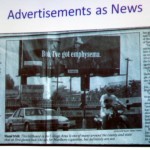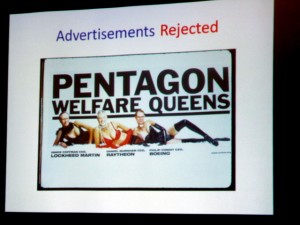At the recent True Spin Conference in Denver, I attended a session titled “How to Create Media-Friendly Imagery,” presented by Jason Salzman, who is the co-founder of Effect Communications, and the author of Making The News: a Guide for Activists and Nonprofits (1998). Salzman was also instrumental in putting together the True Spin Conference.
Salzman began his session with the idea that television is still the dominant news source for national and international news, according to a 2008 Pew survey. It is an undeniable fact that you need visual imagery to get your story onto the TV news. Visual imagery is also important for getting your story into local newspapers, another news source for many people.

Maybe you’re thinking that newspapers and television stations should simply be reporting on important stories, whether or not there is an accompanying clever visual image. That’s a nice idea that doesn’t happen in the real world. You absolutely need to decorate your stories with creative visuals, or else your stories will be invisible to local media. As Salzman says, “This is often ridiculous stuff, but it works.” He presented the conference gathering with a long list of types of visual imagery. He added, “When you see some of these things, you might think they are juvenile or stupid, but they really work. As long as your imagery is on message, it’s good.”
Now I know that some of you probably are still thinking that you’re not going to sell out– you would rather be dignified than be accused of being silly or desperate to get coverage for your important issue. Salzman encouraged the audience members to get over their inhibitions, however. “Stunts can be worthwhile. People forget the source, but they remember the message.”
What kinds of visual imagery seem to catch the attention of the local news media so that you can get your story some real attention? I will walk through Jason’s list of seventeen media-imagery techniques, one-by-one. He has graciously allowed me to reprint some of his slides to illustrate these ideas (using these images makes sense, of course, given the topic). 
1. Costumes. Salzman stated that costumes are the “oldest and best” use of imagery available. By dressing up as a giant pea pod, he was successful in gaining considerable media attention while making the point that George W. Bush and John McCain were “two peas in a pod.” As you can see, he wore his pea pod costume at his session.
As another of many examples, Salzman described how mobs of cameras once gathered around real pigs that were part of a protest of pork barrel projects. A member of the audience asked whether it would be better to surprise the media by suddenly pulling out the costume, but Salzman strenuously disagreed. “Don’t surprise the media. Tell the media you’ll be there [dressed up in your costume].” Members of the media love stories with images. “Tell them you’ll be there and tell them how you’ll be dressed. This will dramatically increase your odds of showing up on the news.”
2. Dramatize a Phrase. Salzman pointed to an example of a huge “budget pie,” to illustrate a story that one-half of discretionary spending went to the military.
3. Banners. If the timing is right, banners can work beautifully. Let the cameras pan those big banners! He gave the example of the New York garbage barge (at left). He also mentioned something that was not exactly a banner, but was highly effective visual: the AIDS Quilt.
4. Create a Replica of the Problem. One activist(at right) fashioned a large number of nuclear weapons out of clay to successfully illustrate her point.

5. Deliver Something or Hand out Something. An example used by Salzman is that of activists throwing the ashes of AIDS victims in protest. Others causes have handed out flowers or cookies to bring attention to an issue. Salzman indicates that many people have successfully handed out cookies to bring attention to an issue.


6. Tours. An example would be the “George W. Bush pants on fire Mobile, an touring automobile decorated to illustrate the point that George W. Bush was dishonest.
7. Re-creating the Actual Problem. An example of this would be protesting discrimination against nursing mothers by bringing a whole bunch of mothers together at one place to nurse their babies in public. Another successful example was having people climbing out of their wheelchairs to protest the lack of public access for the disabled.

8. Advertisements As News. Putting up a billboard that draws such attention can illustrate the issue well enough to attract media attention to the issue itself. Salzman noted that the typical billboard costs $5000 per month.
9. Rejected Advertisements As News. Sometimes a cause will attempt to submit an advertisement, but it is deemed “offensive,” and thus rejected. That rejection (plus a reprint of the rejected ad) can then become the controversy.
10. Nakedness (for example, The Naked Bike Ride).

11. Puppets. A big toothbrush character can draw media attention for the need for improved dental care.
12. Live Animals. People love live animals. Dress them up and use them to draw attention to your story.
13. Create a Spectacle. Sometimes, a principal of a school will lose a bet that requires him to kiss a pig. This kind of thing will often serve as a magnet for media attention.
14. Holidays and Seasonal Images. Nothing like a turkey being carved to illustrate a Thanksgiving story.
15. Primetime Show Connection. If you can wrap your story into a primetime show, it somehow makes your issue much more newsworthy.
16. Burning Something. Burning a flag, a draft card, an AARP card. “The press loves burning.”

17. Organization in Action. If your organization is trying to draw attention to the good works it does, invite the press to come out and watch your organization doing its thing, helping other folks.
At the end of the session, Salzman added that television stations have really cut their budgets and they are “really stretched thin.” The reason to use media-friendly imagery is that they “love this stuff.” It’s no wonder that we are attracted to these images, given that the human brain includes an extraordinarily elaborate mechanism for processing visual images.
To summarize, these are tried and true techniques. Salzman, who has spent his career seeking media attention for his clients, knows from personal experience that these techniques actually work. Therefore, grab your costumes, banners, live animals and matches, and get out there to pitch your cause!



Billboards do not cost $5,000 per month. If you want a billboard on an interstate highway in a Top 20 market, then you might be at or above that figure. But you can get locations on busy surface streets for less than half that in most markets outside the Top 5.